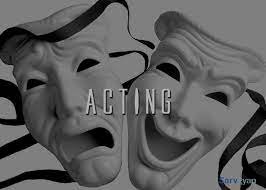What is Acting:
Acting is the art of portraying a character through physical, emotional, and intellectual expression. An actor’s job is to create a believable and authentic representation of a character, whether in a live performance or on screen. Acting requires a combination of talent, training, and experience to create a performance that resonates with the audience.
Acting can be traced back to ancient Greece, where performances were given in amphitheaters as part of religious festivals. However, the modern form of acting as we know it today emerged during the Renaissance, when theater became a popular form of entertainment. From then on, acting continued to evolve, with new techniques and styles emerging throughout the centuries.
One of the primary goals of acting is to create a sense of realism and authenticity in the performance. This involves embodying the character’s physical and emotional traits, such as their posture, voice, and gestures, and using them to create a fully realized character. Actors also use their own experiences and emotions to create a connection with the character they are portraying.

Acting can be broken down into a number of different techniques and approaches, each with its own strengths and weaknesses. For example, the Stanislavski Method is a popular approach to acting that emphasizes the use of personal experiences and emotional recall to create a realistic portrayal of a character. Another approach, known as the Meisner Technique, focuses on listening and responding to the other actors on stage, creating a more organic and spontaneous performance.
In addition to these approaches, actors also use a variety of physical and vocal techniques to create a character. This can include everything from changes in posture and body language to altering their voice and speech patterns. Many actors also use props and costumes to help them get into character, and some even undergo physical transformations, such as gaining or losing weight, to better embody the character.
Acting can be a highly competitive field, with many actors vying for the same roles. As a result, actors must be prepared to audition for roles and work hard to develop their skills and hone their craft. They may also need to work with agents and managers to find work and build their careers.
Acting is often a collaborative process, with actors working closely with directors, writers, and other members of the production team. This requires strong communication and interpersonal skills, as well as the ability to take direction and work within the framework of the production.
Overall, acting is a complex and multifaceted art form that requires a combination of talent, training, and experience. Through their performances, actors can bring to life a wide range of characters and stories, creating a connection with the audience and leaving a lasting impression on those who see their work.
Free Acting Course ( 1 year) :
A one-year free acting course is an opportunity for aspiring actors to gain the skills and knowledge needed to pursue a career in acting. Such a course typically involves a comprehensive curriculum that covers everything from the basics of acting to more advanced techniques and approaches.
The course may be structured as a full-time program, with classes held on a daily basis, or as a part-time program, with classes held on evenings and weekends. It may also be offered in-person, online, or in a hybrid format that combines both in-person and online instruction.

In a one-year free acting course, students can expect to learn the fundamentals of acting, including vocal and physical techniques, improvisation, script analysis, and character development. They may also explore different genres and styles of acting, such as comedy, drama, and musical theater, and learn how to adapt their performances to different types of productions.
In addition to acting classes, a one-year free acting course may also include courses in related fields, such as theater history, stagecraft, and stage management. Students may also have the opportunity to participate in productions, either as actors or as members of the production team, giving them valuable hands-on experience in the industry.
One of the benefits of a one-year free acting course is that it provides students with a structured and supportive environment in which to learn and grow as actors. They have access to experienced instructors who can provide guidance and feedback on their performances, as well as a community of fellow students who share their passion for the craft.
Another benefit is that it can help students build their professional network and make valuable connections within the industry. Many acting courses have partnerships with local theaters and production companies, which can provide students with opportunities to audition for roles and gain exposure to industry professionals.

To be eligible for a one-year free acting course, students may need to meet certain requirements, such as demonstrating a commitment to the craft of acting and having some prior experience or training. They may also need to submit an application and participate in an audition or interview process.
In conclusion, a one-year free acting course can be a valuable opportunity for aspiring actors to gain the skills, knowledge, and experience needed to pursue a career in the industry. It can provide a structured and supportive environment in which to learn and grow, as well as access to industry professionals and opportunities to build a professional network. As with any educational program, students should carefully research and evaluate their options to find a program that meets their needs and goals.
What is Acting:
Acting is the art of portraying a character through physical, emotional, and intellectual expression. An actor’s job is to create a believable and authentic representation of a character, whether in a live performance or on screen. Acting requires a combination of talent, training, and experience to create a performance that resonates with the audience.
Acting can be traced back to ancient Greece, where performances were given in amphitheaters as part of religious festivals. However, the modern form of acting as we know it today emerged during the Renaissance, when theater became a popular form of entertainment. From then on, acting continued to evolve, with new techniques and styles emerging throughout the centuries.
One of the primary goals of acting is to create a sense of realism and authenticity in the performance. This involves embodying the character’s physical and emotional traits, such as their posture, voice, and gestures, and using them to create a fully realized character. Actors also use their own experiences and emotions to create a connection with the character they are portraying.

Acting can be broken down into a number of different techniques and approaches, each with its own strengths and weaknesses. For example, the Stanislavski Method is a popular approach to acting that emphasizes the use of personal experiences and emotional recall to create a realistic portrayal of a character. Another approach, known as the Meisner Technique, focuses on listening and responding to the other actors on stage, creating a more organic and spontaneous performance.
In addition to these approaches, actors also use a variety of physical and vocal techniques to create a character. This can include everything from changes in posture and body language to altering their voice and speech patterns. Many actors also use props and costumes to help them get into character, and some even undergo physical transformations, such as gaining or losing weight, to better embody the character.
Acting can be a highly competitive field, with many actors vying for the same roles. As a result, actors must be prepared to audition for roles and work hard to develop their skills and hone their craft. They may also need to work with agents and managers to find work and build their careers.
Acting is often a collaborative process, with actors working closely with directors, writers, and other members of the production team. This requires strong communication and interpersonal skills, as well as the ability to take direction and work within the framework of the production.
Overall, acting is a complex and multifaceted art form that requires a combination of talent, training, and experience. Through their performances, actors can bring to life a wide range of characters and stories, creating a connection with the audience and leaving a lasting impression on those who see their work.
Free Acting Course ( 1 year) :
A one-year free acting course is an opportunity for aspiring actors to gain the skills and knowledge needed to pursue a career in acting. Such a course typically involves a comprehensive curriculum that covers everything from the basics of acting to more advanced techniques and approaches.
The course may be structured as a full-time program, with classes held on a daily basis, or as a part-time program, with classes held on evenings and weekends. It may also be offered in-person, online, or in a hybrid format that combines both in-person and online instruction.

In a one-year free acting course, students can expect to learn the fundamentals of acting, including vocal and physical techniques, improvisation, script analysis, and character development. They may also explore different genres and styles of acting, such as comedy, drama, and musical theater, and learn how to adapt their performances to different types of productions.
In addition to acting classes, a one-year free acting course may also include courses in related fields, such as theater history, stagecraft, and stage management. Students may also have the opportunity to participate in productions, either as actors or as members of the production team, giving them valuable hands-on experience in the industry.
One of the benefits of a one-year free acting course is that it provides students with a structured and supportive environment in which to learn and grow as actors. They have access to experienced instructors who can provide guidance and feedback on their performances, as well as a community of fellow students who share their passion for the craft.
Another benefit is that it can help students build their professional network and make valuable connections within the industry. Many acting courses have partnerships with local theaters and production companies, which can provide students with opportunities to audition for roles and gain exposure to industry professionals.

To be eligible for a one-year free acting course, students may need to meet certain requirements, such as demonstrating a commitment to the craft of acting and having some prior experience or training. They may also need to submit an application and participate in an audition or interview process.
In conclusion, a one-year free acting course can be a valuable opportunity for aspiring actors to gain the skills, knowledge, and experience needed to pursue a career in the industry. It can provide a structured and supportive environment in which to learn and grow, as well as access to industry professionals and opportunities to build a professional network. As with any educational program, students should carefully research and evaluate their options to find a program that meets their needs and goals.
What is Acting:
Acting is the art of portraying a character through physical, emotional, and intellectual expression. An actor’s job is to create a believable and authentic representation of a character, whether in a live performance or on screen. Acting requires a combination of talent, training, and experience to create a performance that resonates with the audience.
Acting can be traced back to ancient Greece, where performances were given in amphitheaters as part of religious festivals. However, the modern form of acting as we know it today emerged during the Renaissance, when theater became a popular form of entertainment. From then on, acting continued to evolve, with new techniques and styles emerging throughout the centuries.
One of the primary goals of acting is to create a sense of realism and authenticity in the performance. This involves embodying the character’s physical and emotional traits, such as their posture, voice, and gestures, and using them to create a fully realized character. Actors also use their own experiences and emotions to create a connection with the character they are portraying.

Acting can be broken down into a number of different techniques and approaches, each with its own strengths and weaknesses. For example, the Stanislavski Method is a popular approach to acting that emphasizes the use of personal experiences and emotional recall to create a realistic portrayal of a character. Another approach, known as the Meisner Technique, focuses on listening and responding to the other actors on stage, creating a more organic and spontaneous performance.
In addition to these approaches, actors also use a variety of physical and vocal techniques to create a character. This can include everything from changes in posture and body language to altering their voice and speech patterns. Many actors also use props and costumes to help them get into character, and some even undergo physical transformations, such as gaining or losing weight, to better embody the character.
Acting can be a highly competitive field, with many actors vying for the same roles. As a result, actors must be prepared to audition for roles and work hard to develop their skills and hone their craft. They may also need to work with agents and managers to find work and build their careers.
Acting is often a collaborative process, with actors working closely with directors, writers, and other members of the production team. This requires strong communication and interpersonal skills, as well as the ability to take direction and work within the framework of the production.
Overall, acting is a complex and multifaceted art form that requires a combination of talent, training, and experience. Through their performances, actors can bring to life a wide range of characters and stories, creating a connection with the audience and leaving a lasting impression on those who see their work.
Free Acting Course ( 1 year) :
A one-year free acting course is an opportunity for aspiring actors to gain the skills and knowledge needed to pursue a career in acting. Such a course typically involves a comprehensive curriculum that covers everything from the basics of acting to more advanced techniques and approaches.
The course may be structured as a full-time program, with classes held on a daily basis, or as a part-time program, with classes held on evenings and weekends. It may also be offered in-person, online, or in a hybrid format that combines both in-person and online instruction.

In a one-year free acting course, students can expect to learn the fundamentals of acting, including vocal and physical techniques, improvisation, script analysis, and character development. They may also explore different genres and styles of acting, such as comedy, drama, and musical theater, and learn how to adapt their performances to different types of productions.
In addition to acting classes, a one-year free acting course may also include courses in related fields, such as theater history, stagecraft, and stage management. Students may also have the opportunity to participate in productions, either as actors or as members of the production team, giving them valuable hands-on experience in the industry.
One of the benefits of a one-year free acting course is that it provides students with a structured and supportive environment in which to learn and grow as actors. They have access to experienced instructors who can provide guidance and feedback on their performances, as well as a community of fellow students who share their passion for the craft.
Another benefit is that it can help students build their professional network and make valuable connections within the industry. Many acting courses have partnerships with local theaters and production companies, which can provide students with opportunities to audition for roles and gain exposure to industry professionals.

To be eligible for a one-year free acting course, students may need to meet certain requirements, such as demonstrating a commitment to the craft of acting and having some prior experience or training. They may also need to submit an application and participate in an audition or interview process.
In conclusion, a one-year free acting course can be a valuable opportunity for aspiring actors to gain the skills, knowledge, and experience needed to pursue a career in the industry. It can provide a structured and supportive environment in which to learn and grow, as well as access to industry professionals and opportunities to build a professional network. As with any educational program, students should carefully research and evaluate their options to find a program that meets their needs and goals.
What is Acting:
Acting is the art of portraying a character through physical, emotional, and intellectual expression. An actor’s job is to create a believable and authentic representation of a character, whether in a live performance or on screen. Acting requires a combination of talent, training, and experience to create a performance that resonates with the audience.
Acting can be traced back to ancient Greece, where performances were given in amphitheaters as part of religious festivals. However, the modern form of acting as we know it today emerged during the Renaissance, when theater became a popular form of entertainment. From then on, acting continued to evolve, with new techniques and styles emerging throughout the centuries.
One of the primary goals of acting is to create a sense of realism and authenticity in the performance. This involves embodying the character’s physical and emotional traits, such as their posture, voice, and gestures, and using them to create a fully realized character. Actors also use their own experiences and emotions to create a connection with the character they are portraying.

Acting can be broken down into a number of different techniques and approaches, each with its own strengths and weaknesses. For example, the Stanislavski Method is a popular approach to acting that emphasizes the use of personal experiences and emotional recall to create a realistic portrayal of a character. Another approach, known as the Meisner Technique, focuses on listening and responding to the other actors on stage, creating a more organic and spontaneous performance.
In addition to these approaches, actors also use a variety of physical and vocal techniques to create a character. This can include everything from changes in posture and body language to altering their voice and speech patterns. Many actors also use props and costumes to help them get into character, and some even undergo physical transformations, such as gaining or losing weight, to better embody the character.
Acting can be a highly competitive field, with many actors vying for the same roles. As a result, actors must be prepared to audition for roles and work hard to develop their skills and hone their craft. They may also need to work with agents and managers to find work and build their careers.
Acting is often a collaborative process, with actors working closely with directors, writers, and other members of the production team. This requires strong communication and interpersonal skills, as well as the ability to take direction and work within the framework of the production.
Overall, acting is a complex and multifaceted art form that requires a combination of talent, training, and experience. Through their performances, actors can bring to life a wide range of characters and stories, creating a connection with the audience and leaving a lasting impression on those who see their work.
Free Acting Course ( 1 year) :
A one-year free acting course is an opportunity for aspiring actors to gain the skills and knowledge needed to pursue a career in acting. Such a course typically involves a comprehensive curriculum that covers everything from the basics of acting to more advanced techniques and approaches.
The course may be structured as a full-time program, with classes held on a daily basis, or as a part-time program, with classes held on evenings and weekends. It may also be offered in-person, online, or in a hybrid format that combines both in-person and online instruction.

In a one-year free acting course, students can expect to learn the fundamentals of acting, including vocal and physical techniques, improvisation, script analysis, and character development. They may also explore different genres and styles of acting, such as comedy, drama, and musical theater, and learn how to adapt their performances to different types of productions.
In addition to acting classes, a one-year free acting course may also include courses in related fields, such as theater history, stagecraft, and stage management. Students may also have the opportunity to participate in productions, either as actors or as members of the production team, giving them valuable hands-on experience in the industry.
One of the benefits of a one-year free acting course is that it provides students with a structured and supportive environment in which to learn and grow as actors. They have access to experienced instructors who can provide guidance and feedback on their performances, as well as a community of fellow students who share their passion for the craft.
Another benefit is that it can help students build their professional network and make valuable connections within the industry. Many acting courses have partnerships with local theaters and production companies, which can provide students with opportunities to audition for roles and gain exposure to industry professionals.

To be eligible for a one-year free acting course, students may need to meet certain requirements, such as demonstrating a commitment to the craft of acting and having some prior experience or training. They may also need to submit an application and participate in an audition or interview process.
In conclusion, a one-year free acting course can be a valuable opportunity for aspiring actors to gain the skills, knowledge, and experience needed to pursue a career in the industry. It can provide a structured and supportive environment in which to learn and grow, as well as access to industry professionals and opportunities to build a professional network. As with any educational program, students should carefully research and evaluate their options to find a program that meets their needs and goals.








